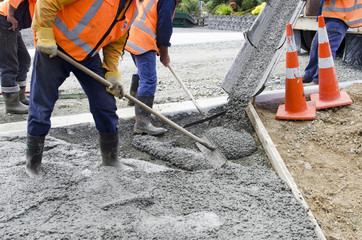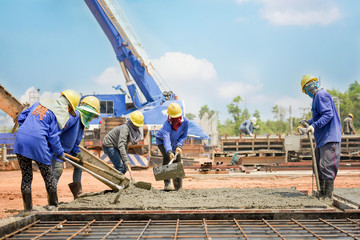If you pour concrete into a driveway, sidewalk, foundation, or another structure, it will eventually crack. The good news is that it will only happen briefly if you finish your concrete correctly.

The successful Concrete Repair Colorado Springs depends on many factors. These include determining the cause of concrete damage, selecting suitable repair techniques and materials, and reparation process preparation.
When concrete cracks, it is an indication of an underlying problem that must be dealt with. Cracks will continue to appear until the instability that caused them is addressed. It is important that all of the factors that contributed to the damage be addressed before starting a repair project. Failure to address all of the contributing factors can cause the repair work to fail.
Whether you choose to use an epoxy crack sealant or concrete patching product, the first step is to clean out the cracks. Scrub the area with a wire brush and rinse it thoroughly, scrubbing again to be sure that all of the loose debris is removed. This will help the concrete repair product or crack filler to adhere to the surface of the concrete and create a solid bond.
It is generally a good idea to use the same concrete mix that was used for the original structure when repairing cracks in concrete. This will help ensure that the repair material makes an integral bond with the concrete matrix and minimizes shrinkage cracking. If this is not possible, a low w/c concrete with a high percentage of coarse aggregate can be used for the repair.
Another option for repairing concrete is to inject the cracks with an epoxy or similar material. This is usually only a viable solution when the cracks are dry and not leaking, as moisture tolerant epoxies cannot be used in wet cracks.
A good way to approach the injection of cracks is to use a foam backer rod. This is available in a range of sizes and can be stuffed into the crack with a screwdriver, leaving a hole to place the injection port. When using this method, it is important to place the injection ports so that they will be in line with the crack direction.
If you choose to use a concrete crack filler, follow the instructions on the label. Most crack fillers require the application of a thin layer of bonding adhesive before applying the crack filler. This is a vital step that should not be overlooked as it helps the crack filler or sealant to adhere to the existing concrete and prevents it from lifting.
Repairing Leaks
Leaks in concrete can be a major problem. It’s important to stop them as soon as possible to avoid costly damage and a health risk. Concrete repair products are available to help you with this. They are easy to use and work well on most types of concrete cracks.
The best way to fix leaks in concrete is to inject an epoxy product into the crack. This is an effective and cost-efficient solution. But it’s important to prepare the crack before applying the injection. This is the only sure way to ensure that the crack will be completely waterproof once it’s been repaired.
Water leaks in concrete often start in the surface of the slab. They can also be caused by underground plumbing problems. They may be exacerbated by deicing salts that corrode the metal in plumbing lines and cause them to rupture or disconnect from the concrete slab. A plumbing failure or a slab leak can be expensive to repair and may require excavation.
Concrete tanks can be damaged by freeze/thaw movements, impacts and equipment vibration. They can also develop leaks that are difficult to seal with traditional methods that involve draining, cleaning and surface prep. The concrete can then be coated with a chemical resistant resin to create a long-lasting, durable waterproof barrier.
This is one of the most common repairs in precast concrete structures. A large number of these defects occur during the production process and are first observed early in the stripping or moving of dry-cast products before they’ve had time to set. They usually manifest as non-structural surface anomalies such as honeycombing, bugholes or small voids.
Excessive water in the concrete mix increases porosity, decreases strength, increases shrinkage (except autogenous shrinkage of low water to cement concrete) and reduces abrasion resistance. The effect is often masked by other damage such as freeze/thaw disintegration or abrasion.
Epoxy injected under pressure into concrete cracks “glues” the concrete back together and restores lost tensile and compressive strength and structural integrity. It can also repair damage caused by corrosion of reinforcing steel and spalling resulting from water intrusion. This type of repair does not suit dynamic cracks subject to movement, but it’s a good option for concrete repair in static conditions such as floors, beams, columns and walls.
Repairing Slabs
When concrete is exposed to long periods of moisture, it can expand and crack. This type of cracking is called plastic settlement cracking and is usually confined to the surface of the slab. It is not a serious problem in itself as it only effects the appearance of the concrete element but if allowed to progress further with drying shrinkage, thermal movement or loading the crack may eventually develop into a full-depth structural crack.
In these cases the damaged concrete needs to be repaired. The repair process begins with a concrete condition evaluation to determine the cause of the deterioration and to select the appropriate repair methods and materials. The evaluation may include a review of design and construction documents, inspection and survey data, destructive testing and nondestructive tests and laboratory results from chemical and petrographic analysis of concrete samples.
Once the concrete is reformed, a bonding agent should be applied to ensure the new concrete adheres to the existing slab. This is particularly important where a new section of concrete is being placed in a different position than the original. It is also recommended where a concrete repair is being made overhead, for example on a bridge deck or a garage floor, to protect the reinforcement bar from corrosion.
It is also essential that the crack is cleaned thoroughly prior to application of the repair material. This is to ensure that the crack does not become a passage way for water, which will inevitably penetrate the concrete element and lead to further deterioration and even spalling.
Narrow cracks in concrete can often be repaired using a foam backer rod. This is inserted into the crack and pushed in place with a screwdriver. The rod should be slightly larger than the crack width and a layer of concrete mix is then poured over it to seal the crack. When the concrete has set, a final coat of surface sealant can be applied, if required.
For larger concrete repairs that involve reforming a whole section of a slab, it is usually necessary to construct forms. These must be strong and mortar-tight to resist the forces of expansion and contraction of the concrete. To reduce the cost of forming it is advisable to design the structure to avoid curves. The front panels of a form should be constructed as the placing of concrete progresses, this will help to make it easier to get the concrete in place and also help to prevent sagging of the formed concrete.
Repairing Foundations
For large, long cracks that run vertically or diagonally along foundation walls and are wider than a hairline, try filling them with polyurethane, silicone, or latex concrete caulk. Apply the caulk with a caulking gun, then wait 10 minutes for it to expand and settle. Repeat as needed if the crack widens due to weather changes.
A major cause of damage to concrete is soil shifting beneath the foundation. To stabilize the foundation, you can drive steel piles or pour concrete piers to lift and support it. If the problem is extensive, you may need to excavate and replace the foundation.
For sunken concrete slabs such as patios, driveways, swimming pool decks, and garage floors, a contractor can use a method called slabjacking. He drills strategically placed holes in the slab and pumps a grout mixture under the surface, helping the slab rise in only a couple of hours.
If your basement wall bows severely and you cannot make it straight with shimming or reinforcing the sill plate, you may need to excavate part or all of the foundation and rebuild it — a $30,000 to $40,000. If the bow is caused by a water pipe leak or a drainage problem in your yard sending cascading water alongside the foundation, a simple fix is often possible with timbers and concrete.
Before attempting any repairs, look at the big picture. Generally, a house’s foundation develops cracks over time for many reasons. The soil underneath moves, rain infiltrates the concrete, and expansion and contraction causes the concrete to stress and crack. Inspect moldings and trim boards for warping, mortar joints in brick veneer for cracking, and windows in low areas for signs of a shifting foundation.
Once you have filled and sealed the cracks in your foundation, protect it by applying waterproof masonry sealant. Work the sealant thoroughly into the cracks and a few inches beyond them to ensure a good, tight seal. You may also want to consider painting your foundation with a specially formulated, water-based paint. These products will help prevent the cracks from reopening and may extend the life of your concrete.

